Azeotropic mixture of water and C2H5OH boils at 351 K. By distilling the mixture it is possible to obtain
pure C2H5OH only
Pure water only
NeitherC2H5OH nor water
Both water and C2H5OH in pure state
The correct Answer is:c
To solve the problem regarding the azeotropic mixture of water and ethanol (C₂H₅OH) that boils at 351 K, we need to understand the nature of azeotropes and what can be obtained from distillation.
1. Understanding Azeotropes:
- An azeotropic mixture is a mixture of two or more liquids that has a constant boiling point and composition throughout the distillation process. This means that when the mixture is boiled, the vapor produced has the same composition as the liquid mixture.
2. Composition of the Mixture:
- In the case of the azeotropic mixture of water and ethanol, the boiling point is given as 351 K. At this temperature, the mixture will not separate into pure components upon boiling.
3. Distillation Process:
- During distillation of an azeotropic mixture, the vapor that forms will have the same ratio of components as the liquid mixture. Therefore, no matter how much you distill, you will not be able to obtain pure ethanol or pure water.
4. Conclusion:
- Since the question asks what can be obtained from distilling the azeotropic mixture, the answer is that it is not possible to obtain pure ethanol or pure water. The composition remains constant, and you will continue to get a mixture of water and ethanol.
Final Answer:
By distilling the azeotropic mixture of water and ethanol that boils at 351 K, it is not possible to obtain pure ethanol or pure water. The distillation will yield a mixture with the same composition as the original azeotropic mixture.
- An azeotropic mixture is a mixture of two or more liquids that has a constant boiling point and composition throughout the distillation process. This means that when the mixture is boiled, the vapor produced has the same composition as the liquid mixture.
- In the case of the azeotropic mixture of water and ethanol, the boiling point is given as 351 K. At this temperature, the mixture will not separate into pure components upon boiling.
- During distillation of an azeotropic mixture, the vapor that forms will have the same ratio of components as the liquid mixture. Therefore, no matter how much you distill, you will not be able to obtain pure ethanol or pure water.
- Since the question asks what can be obtained from distilling the azeotropic mixture, the answer is that it is not possible to obtain pure ethanol or pure water. The composition remains constant, and you will continue to get a mixture of water and ethanol.
By distilling the azeotropic mixture of water and ethanol that boils at 351 K, it is not possible to obtain pure ethanol or pure water. The distillation will yield a mixture with the same composition as the original azeotropic mixture.
Topper's Solved these Questions
- DILUTE SOLUTIONBOOK - NARENDRA AWASTHI ENGLISHCHAPTER - DILUTE SOLUTIONEXERCISE - leval-02
26 Videos
- DILUTE SOLUTIONBOOK - NARENDRA AWASTHI ENGLISHCHAPTER - DILUTE SOLUTIONEXERCISE - leval-03
23 Videos
- CHEMICAL EQUILIBRIUMBOOK - NARENDRA AWASTHI ENGLISHCHAPTER - CHEMICAL EQUILIBRIUMEXERCISE - Match the column
1 Videos
- ELECTROCHEMISTRYBOOK - NARENDRA AWASTHI ENGLISHCHAPTER - ELECTROCHEMISTRYEXERCISE - Subjective problems
14 Videos
Similar Questions
An azeotropic mixture of HCl and water has
View SolutionThe azeotropic mixture of water and HCl boils at 110∘C when this mixture is simple distilled it is possible to obtain
View SolutionAzeotropic mixture of water (B.P. = 100°C) and nitric acid (B P = 83°C) boils at 393.5 K During fractional distillation of mixture, it is possible to obtain
View SolutionThe azeotropic mixture of water (b.pt 100∘C) and HCl (b.pt 85∘C) boils at 108.5∘C. When this mixture is distilled, it is possible to obtain:
View SolutionThe azeotropic mixture of water (B.P.=100∘C) and HCl(B.P.=86∘C)boils at about 120∘C. During fractional distillation of this mixture it is possible to obtain :
View Solutionrepresents the distillation of mixture of liquid A and liquid B which gives both of pure liquid A and B . Represents the azeotropic mixture of HNO3 and H2O which distillation gives an azeotropic mixture and either of pure liquid. We cannot separate both the pure liquid, i.e., H2O and HNO3.
a solution of 50% of A and 50% of B on distillation results into
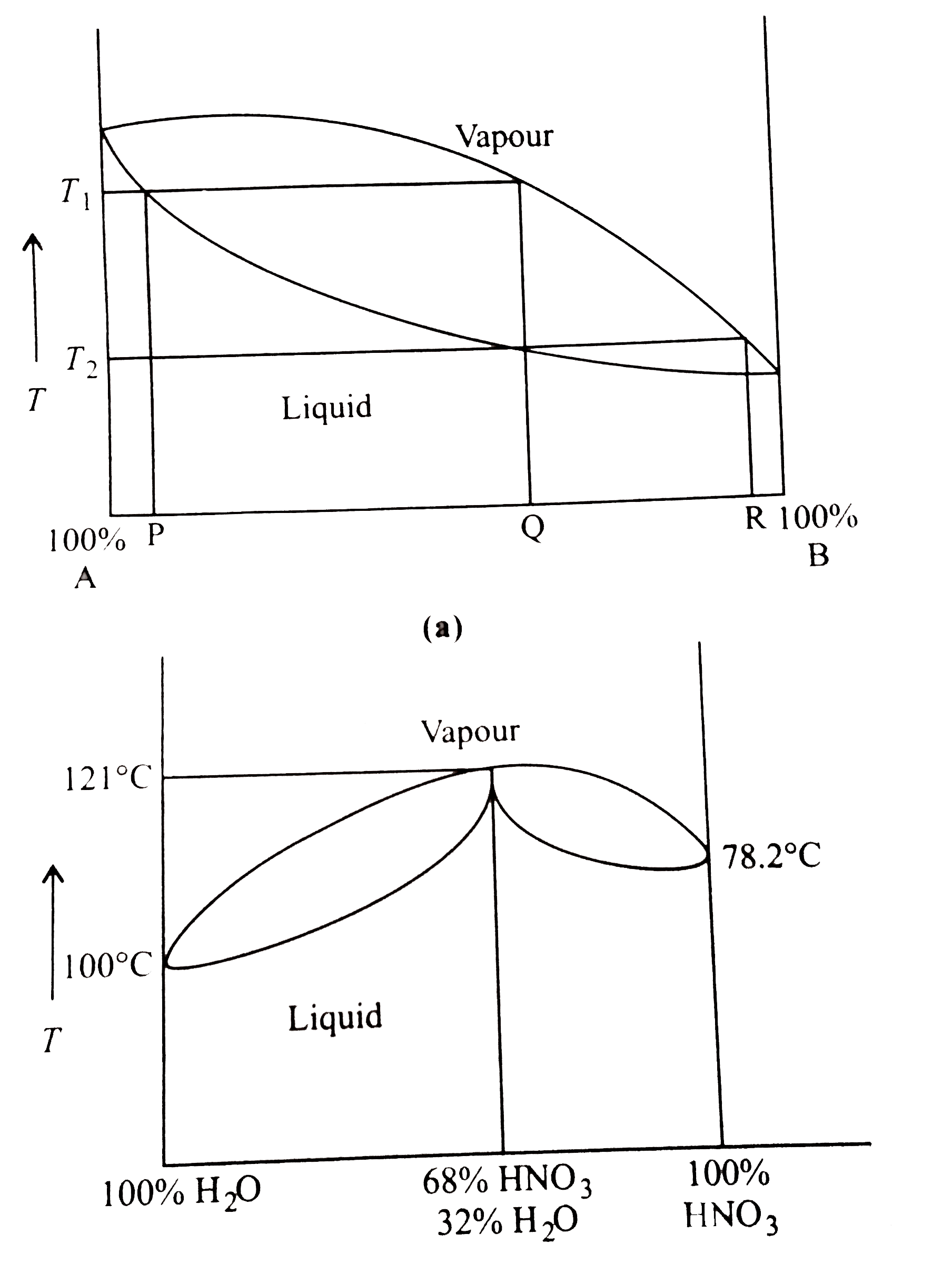
Separation of an azeotropic mixture and pure A .
Separation of an azeotropic mixture and pure B .
Separation of both pure A and pure B .
None of these
View Solutionrepresents the distillation of mixture of liquid A and liquid B which gives both of pure liquid A and B . Represents the azeotropic mixture of HNO3 and H2O which distillation gives an azeotropic mixture and either of pure liquid. We cannot separate both the pure liquid, i.e., H2O and HNO3.
What is the result of distilling a mixture of 80%HNO3 and 20%H2O?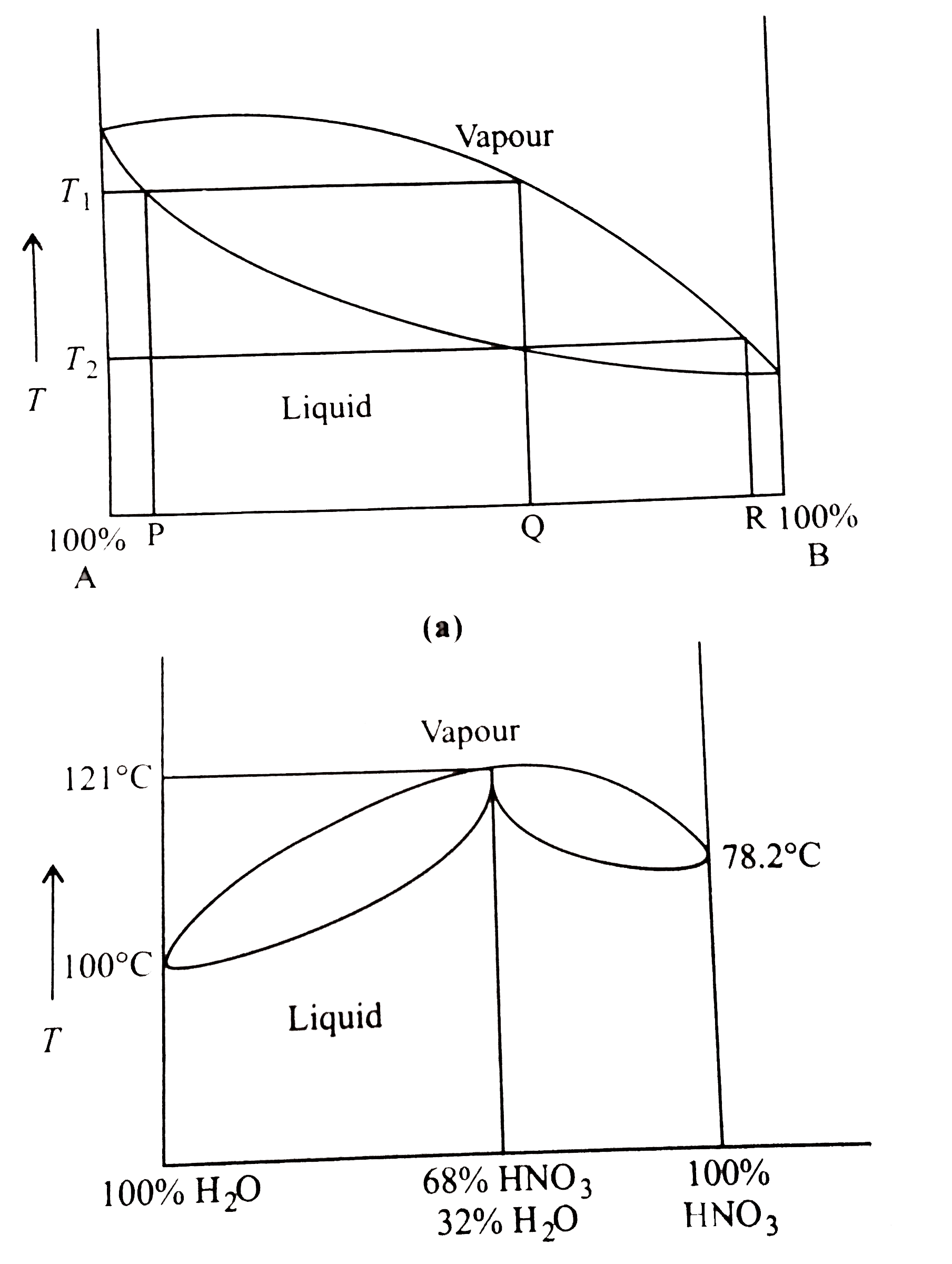
(a)Pure H2O and azeotropic mixture can be separated.
(b)Pure H2O and pure HNO3 can be separated.
(c)Pure HNO3 and azeotropic mixture can be separated.
(d)None of these
View Solutionrepresents the distillation of mixture of liquid A and liquid B which gives both of pure liquid A and B . Represents the azeotropic mixture of HNO3 and H2O which distillation gives an azeotropic mixture and either of pure liquid. We cannot separate both the pure liquid, i.e., H2O and HNO3.
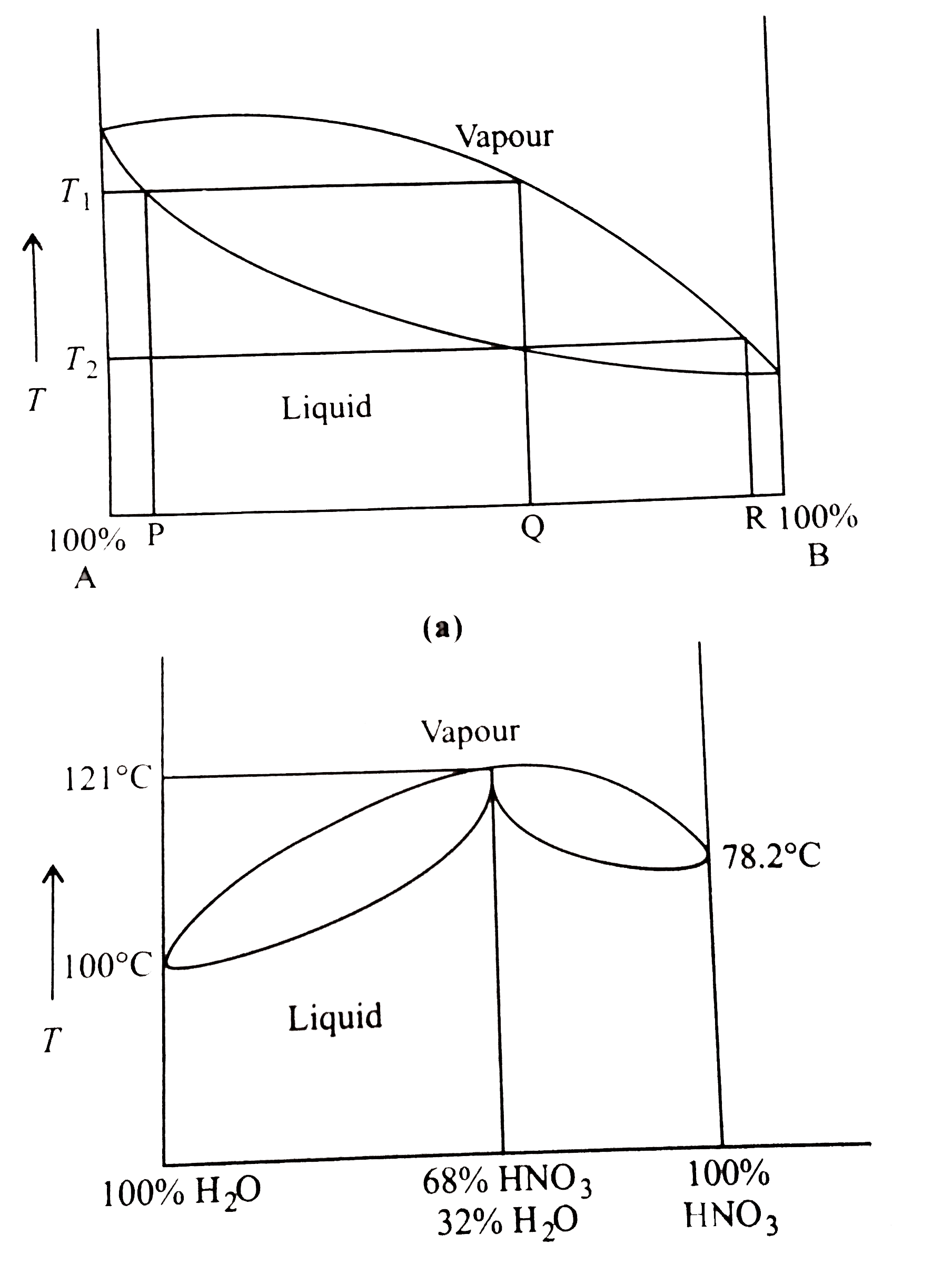
What is the result of distilling a mixture of 50%HNO3 and 50%H(2)O ?
a.Pure water and azeotropic mixtue can be separated.
b.Pure H2O and pure HNO3 can be separated.
c.Pure HNO3 and azeotropic mixture can be separated.
d.None of these
View Solutionrepresents the distillation of mixture of liquid A and liquid B which gives both of pure liquid A and B . Represents the azeotropic mixture of HNO3 and H2O which distillation gives an azeotropic mixture and either of pure liquid. We cannot separate both the pure liquid, i.e., H2O and HNO3.
At temperature T1 and composition Q, which of the following is true?
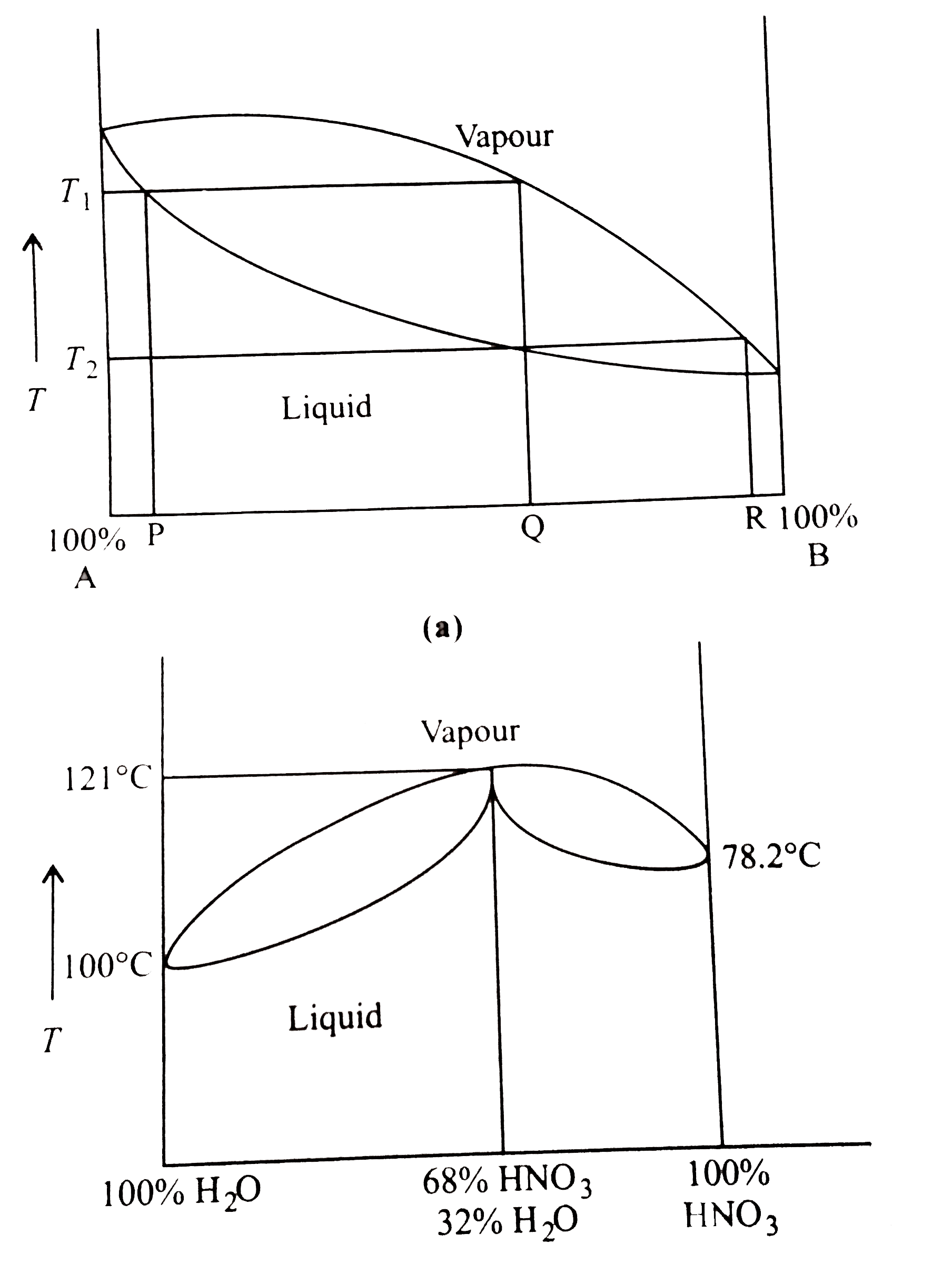
a.Vapour phase is richer in B while liquid phase is richer in A .
b.Distillation of composition Q gives only pure A .
c.Distillation of composition Q gives only pure A and pure B .
d.Distillation of composition Q gives higher percentage of B and A .
View Solutionrepresents the distillation of mixture of liquid A and liquid B which gives both of pure liquid A and B . Represents the azeotropic mixture of HNO3 and H2O which distillation gives an azeotropic mixture and either of pure liquid. We cannot separate both the pure liquid, i.e., H2O and HNO3.
Which of the following statements is/are correct?
i. HNO3 solution is not obeying the Raoult's law.
ii. More the difference in vapour pressure of pure compounds forming a mixture, easier to separate them through distillation.
iii. T2 is less than T1 because the liquid of composition Q is richer in more volatile component.
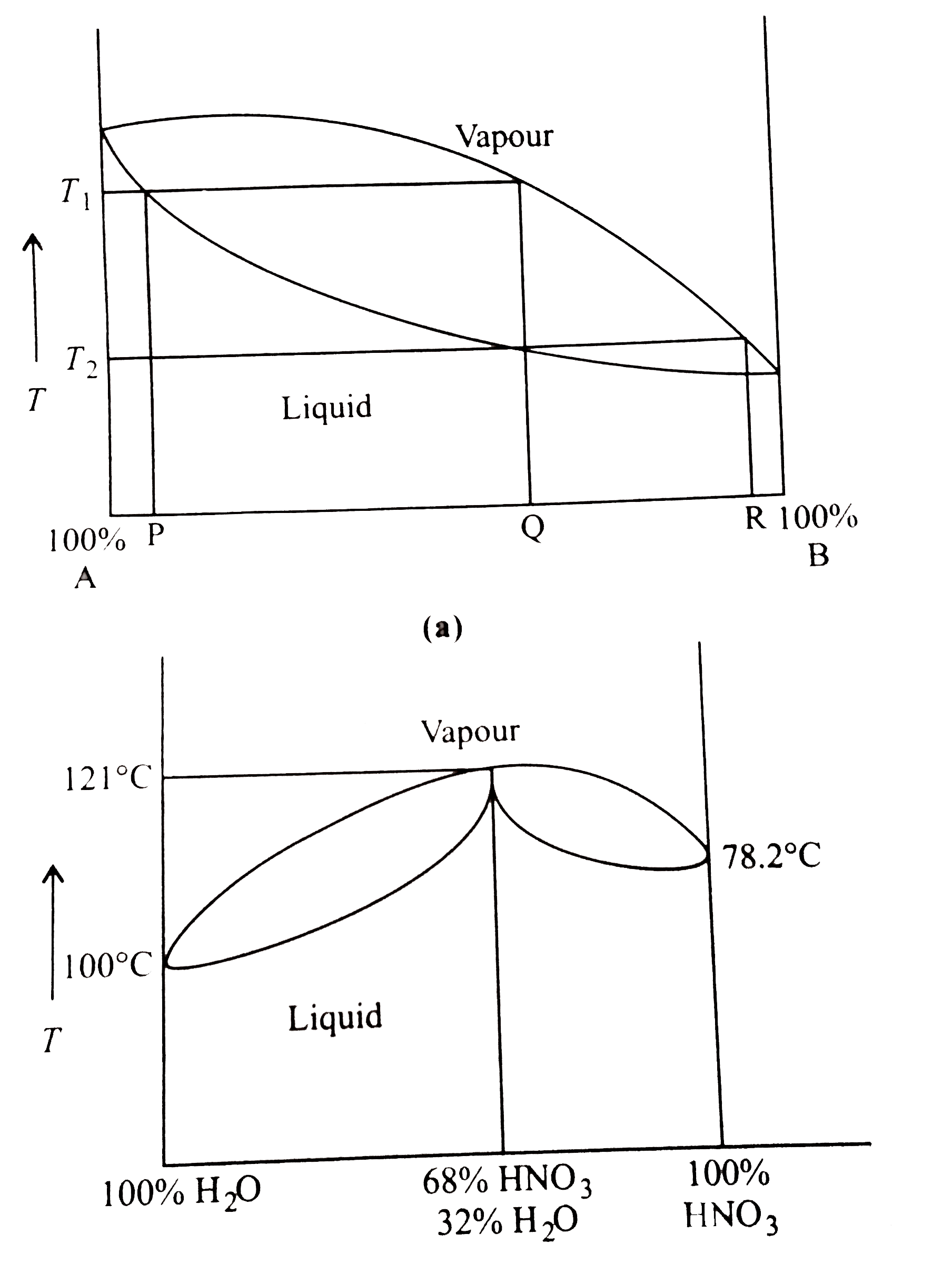
View Solution
